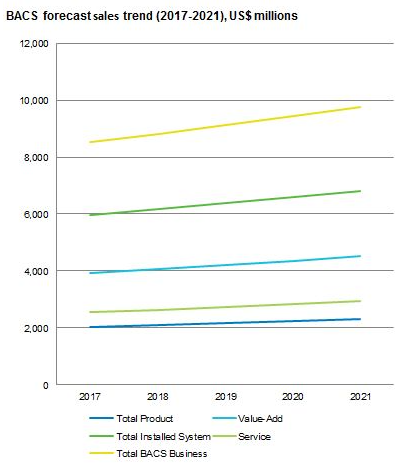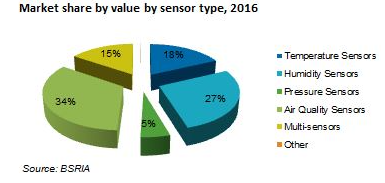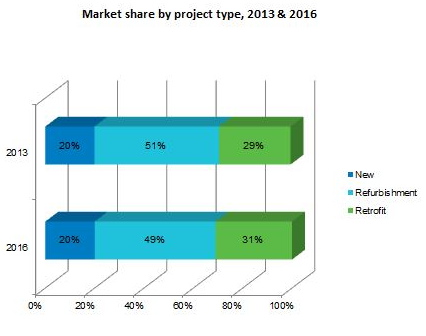BACS market in North America
The BSRIA BACS North America – In-Depth Report reveals that sales of BACS products (Building Automation and Control Systems) was US$ 1,970 million in 2016, an increase of 2.5% on 2015, while total installed systems sales was US$ 5,801 million.
The total value of service and maintenance was US$ 2,475 million, pushing the total value of BACS business in 2016 to US$ 8,276 million.
Zoltan Karpathy, Manager – Intelligent Buildings and Homes, BSRIA, said: “The main factors driving market growth have been the uptake of data analytics and concern over energy costs.
BACS forecast sales trend (2017-2021), US$ millions
The general performance trend of the BACS industry has been closely related to the USA’s and Canada’s economy and construction. As USA’s BACS market accounts for 86% of North America, the effect of the USA is much stronger than that of Canada. So, looking at the overall picture, Canada’s slowdown in the last two years is less visible.
USA rebounded strongly from 2010, where recession and annual growth of the economy has generally oscillated within the range of 2-3%.
Non-residential construction had a slight decrease in 2014 (-0.4%) but recovered strongly with growth rates within the range of 7-8% in 2015 and 2016.
Market share by value by sensor type, 2016
Overall, in the total market, the main drivers of growth are refurbishment and retrofit (not new construction) which benefit from a continued interest to invest in energy saving HVAC system upgrades. The US BACS market had cautious spending in 2016 due to the presidential election.
The value of DDC controllers was US$ 812 million, of which 63% are field level controllers; their share has been growing faster than the sometimes overcomplicated automation controllers.
Currently the controller market is dominated by the top five manufacturers, Honeywell, Johnson Controls, Siemens, Trane and Schneider Electric.
BACS historical sales trend (2011-2016), US$ millions
Zoltan said: “In terms of value, air-quality type (including CO2) is the most popular type of sensor in North America, accounting for 34% by value. This trend is due to the emphasis placed by companies on healthy living and increased productivity. Also it is policy driven as most states mandate legislation for air quality in schools and universities.”
A major trend is to add energy data analytics (Building energy management systems - BEMS) to existing BACS solutions, which continues to support retrofit/refurbishment sales, allowing BACS systems previously working in isolation to be integrated with other applications via open communication protocols.
Zoltan continued: “With the building automation segment continuing to grow in North America, there is an incentive for new players to enter the market in order to gain a share of this expanding business. This process is reinforced by the increasing trend towards integration of building automation and controls with other areas of smart technology, such as cloud-based monitoring management and smart homes. As one of the world’s largest markets for building automation, North America is a natural target for such activities.”
Market share by project type, 2013 & 2016
The purpose of the study was to provide a detailed quantitative and qualitative assessment of the current and future markets for intelligent control systems in non-residential buildings in North America.
For more information see BSRIA Market Intelligence.
--BSRIA
[edit] Related articles on Designing Buildings Wiki
Featured articles and news
The UK's Modern Industrial Strategy: A 10 year plan
Previous consultation criticism, current key elements and general support with some persisting reservations.
Building Safety Regulator reforms
New roles, new staff and a new fast track service pave the way for a single construction regulator.
Architectural Technologist CPDs and Communications
CIAT CPD… and how you can do it!
Cooling centres and cool spaces
Managing extreme heat in cities by directing the public to places for heat stress relief and water sources.
Winter gardens: A brief history and warm variations
Extending the season with glass in different forms and terms.
Restoring Great Yarmouth's Winter Gardens
Transforming one of the least sustainable constructions imaginable.
Construction Skills Mission Board launch sector drive
Newly formed government and industry collaboration set strategy for recruiting an additional 100,000 construction workers a year.
New Architects Code comes into effect in September 2025
ARB Architects Code of Conduct and Practice available with ongoing consultation regarding guidance.
Welsh Skills Body (Medr) launches ambitious plan
The new skills body brings together funding and regulation of tertiary education and research for the devolved nation.
Paul Gandy FCIOB announced as next CIOB President
Former Tilbury Douglas CEO takes helm.
UK Infrastructure: A 10 Year Strategy. In brief with reactions
With the National Infrastructure and Service Transformation Authority (NISTA).
Ebenezer Howard: inventor of the garden city. Book review.
The Grenfell Tower fire, eight years on
A time to pause and reflect as Dubai tower block fire reported just before anniversary.
Airtightness Topic Guide BSRIA TG 27/2025
Explaining the basics of airtightness, what it is, why it's important, when it's required and how it's carried out.
Construction contract awards hit lowest point of 2025
Plummeting for second consecutive month, intensifying concerns for housing and infrastructure goals.
Understanding Mental Health in the Built Environment 2025
Examining the state of mental health in construction, shedding light on levels of stress, anxiety and depression.


























